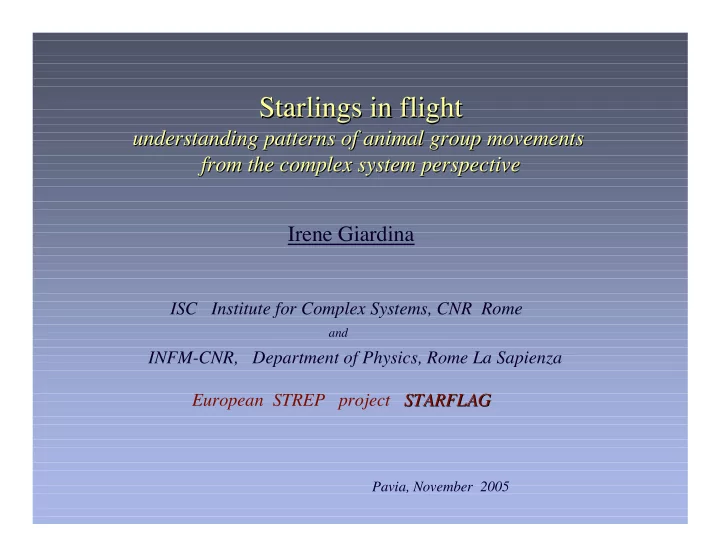

Starlings in flight Starlings in flight understanding patterns of animal group movements understanding patterns of animal group movements from the complex system perspective from the complex system perspective Irene Giardina ISC Institute for Complex Systems, CNR Rome and INFM-CNR, Department of Physics, Rome La Sapienza European STREP project STARFLAG STARFLAG Pavia, November 2005
STARLING FLOCKS Termini railway station, Rome Evening roosting time, November 2004
Collective phenomena often occur in biological systems Collective phenomena Bacteria colonies , blood cells, insects swarms, fish schools, birds flocks, quadrupets herds What are the rules governing coordination and collective motion ?
Collective phenomena have been widely studied in physics • Cooperative behaviour in phase transitions and ordering • Local interactions can generate long range order • Universality, renormalization the details are not important • Efficient simple models The Physics Paradigm the microscopic mechanisms determining flocking pattern formation and coordinated collective motion are local and simple and do not depend dramatically on the complex nature of the individuals SIMPLE MODELS Hypothesis !
Minimal Models of Flocking Each individual bird determines its direction of motion on each time step by averaging Each individual bird determines its direction of motion on each time step by averaging the direction of its neighbours (allelomimesis) with some noise the direction of its neighbours (allelomimesis) with some noise Self-Propelled Particles Reynolds, Comput. Graph., 87 Vicsek et al., PRL 95 direction velocity noise • Nonequilibrium analog of the ferromagnetic XY model (in 2D) Rotational Symmetry • Onset of collective motion for small noise, even in 2D (Mermin-Wagner does NOT hold) • Navier-Stokes like equations for the coarse-grained velocity Toner & Tu, PRL 1995 Non trivial RG fixed point Convective relevant Exact exponents in D=2 non-linear terms Effective long-range interactions
SPP with cohesion Gregoire, Chate & Tu, PRL 2001 Gregoire & Chate, PRL 2004 Gregoire, Chate & Tu, PRE 2004 Hard-core repulsion + Short-range attraction ( r 0 ) • Non trivial infinite space limit cohesive moving flocks in infinite space • Complex phase diagram solid moving solid Cohesive/Sparse Gas - Liquid - Solid Moving/Non moving moving liquid liquid • Discontinuous first order transitions
Experiments Flock shape and movement Stereoscopic 3D reconstruction of Individual birds positions Individual birds trajectories Stereometry Stereoscopic Photography • image elaboration 2 D images • birds recognition • stereoscopic matching 3D coordinates • epipolar post-calibration
Z Stereoscopic shift Stereoscopic shift lens lens B A f CCD CCD x B x A d f = 4000 • the larger the distance, the better the resolution Z = 200 m d = 20 m δ Z = 0.5 m neighbouring birds δ s = 1 α • misalignements strongly affect absolute distances α = 0.001 rad δ Z / Z = 2.0 / 200 α = 0.0003 rad δ Z / Z = 0.5 / 200
The setup Syncronized ( < 1 ms) interlaced 25 m Palazzo Massimo, Rome • Alignement 4 with precision ~ 0.001 rad There are 5 external angles to be fixed 1 with precision ~ 0.0005 rad • Calibration There are the internal parameters to be calibrated (or postcalibrated) • Temporization 5fps @ 16m/s : birds travel 3.2 m between two consecutive shots 2 interlaced cameras 10 fps 1.6 m
Matching and 3D reconstruction • Bird recognition Contrast filters, segmentation algorithms
• Matching 1) Pattern recognition algorithm M 0 Zero-matching (partial) 2) Epipolar geometry F = fundamental matrix depends on the angles ! affected by JPEG Noise 3) K-assignement Matching between different set of points with measure F
Planar structure ! Planar structure !
A more complex flock
Discoidal shape Discoidal shape
+ flock g(r) Radial distribution function g(r) bio * Liquid like !!! r Γ (r) Conditional mass Γ (r) Scale free (???) very preliminary Finite size effect (L< L *) Errors in segmentation Errors in matching ? Density = N/V Synthetic flock with same V, N and overall shape as the bio one, but with a uniform distribution of points r
Summary and Perspectives • 3D reconstruction of starling flocks is demanding but possible • Experimental efficiency related to Camera specifications (Canon Eos D Mark II, 8.2 Mp, 8.5 fps) alignement capabilities • Static reconstruction of individual flocks • Statistics correlation functions, shape, heterogeneity • Dynamics trajectory reconstruction, diffusion, convection Comparison with models
The team Alberto Orlandi (INFM-CNR, STARFLAG postdoc) computer vision, epipolar geometry Vladimir Zdravkovic (INFM-CNR, STARFLAG postdoc) Michele Ballerini experimental setup, data taking (INFM-CNR, STARFLAG graduate student) electronics, timer, data taking Evaristo Cisbani ( ISS) electronics, timer Andrea Procaccini (La Sapienza, PhD student) experimental setup, data analysis Massimiliano Viale ( Roma 3 & INFM-CNR, PhD student) epipolar geometry Nicola Cabibbo (La Sapienza) Andrea Cavagna (INFM & ISC-CNR ) Irene Giardina (INFM & ISC-CNR) Giorgio Parisi (La Sapienza, INFM & ISC)
Recommend
More recommend